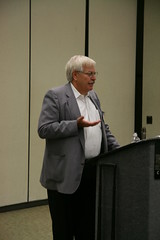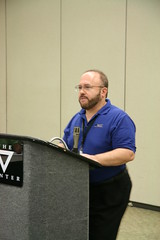
About UsThe Numismatic Bibliomania Society is a non-profit organization promoting numismatic literature. For more information please see our web site at coinbooks.org SubscriptionsThose wishing to become new E-Sylum subscribers (or wishing to Unsubscribe) can go to the following web page link MembershipThere is a membership application available on the web site Membership Application To join, print the application and return it with your check to the address printed on the application. Membership is only $15 to addresses in the U.S., $20 for First Class mail, and $25 elsewhere. For those without web access, write to: David M. Sundman, Secretary/TreasurerNumismatic Bibliomania
Society AsylumFor Asylum mailing address changes and other membership questions, contact David at this email address: dsundman@LittletonCoin.com SubmissionsTo submit items for publication in The E-Sylum, just Reply to this message, or write to the Editor at this address: whomren@coinlibrary.com
BUY THE BOOK BEFORE THE COINYou won't regret it! |
- WAYNE'S WORDS: THE E-SYLUM AUGUST 3, 2008
- FANNING NUMISMATIC LITERATURE AUCTION SALE OCTOBER 28, 2008
- NEW BOOK: AUSTRALIAN HISTORICAL MEDALS 1788-1988 BY LES CARLISLE
- NEW BOOK: CHINESE CHARMS: ART, RELIGION AND FOLK BELIEF BY ALEX FANG
- COIN FICTION BOOK: THE VENETIAN BETRAYAL BY STEVE BERRY
- NBS NUMISMATIC LITERATURE SYMPOSIUM AUGUST 1, 2008
- NUMISMATIC LITERARY GUILD 2008 AWARD WINNERS
- E-SYLUM EDITOR WINS BURNETT MEMORIAL AWARD
- FRANK CAMPBELL AND THE ANS LIBRARY: AN APPRECIATION
- AN ODE TO THE DISAPPEARING LOCAL COIN CLUB LIBRARY
- NUMISMATIC RESEARCHER BURDETTE APPOINTED TO COINAGE ADVISORY COMMITTEE
- MORE ON COIN-MAKING AND BUTTON-MAKING
- MORE ON THE NEW E-SYLUM FORMAT
- WAYNE'S NUMISMATIC DIARY: JUNE 31 - AUGUST 1, 2008
- SUSPECT U.S. ASSAY OFFICE OF GOLD $20
- COINS EXHIBITED AT THE NATIONAL MUSEUM OF THE AMERICAN INDIAN
- COUNTERFEIT CANADIAN $2 COINS DISCOVERED IN CIRCULATION
- BLIND TO TESTIFY BEFORE HOUSE SUBCOMMITTEE ABOUT PAPER MONEY CHANGES
- FIRST-TIME METAL DETECTORISTS UNCOVER ROMAN COIN HOARD
- ZIMBABWE'S INFLATION YET TO SURPASS HUNGARY'S
- U.S. AUTHORITIES INVESTIGATE BURIED LOOT
- OOPS! WRONG LARRY SHOWN ON IDAHO CAMPAIGN BUTTONS
- FEATURED WEB SITE: GALLERY OF BOOK TRADE LABELS
WAYNE'S WORDS: THE E-SYLUM AUGUST 3, 2008
 Among our recent subscribers are Larry
Shepherd, courtesy of John Wilson, Kay Freeman, courtesy of Katie Jaeger,
and Rory Rea, courtesy of W. David Perkins. Welcome aboard! We now have
1,166 subscribers.
Among our recent subscribers are Larry
Shepherd, courtesy of John Wilson, Kay Freeman, courtesy of Katie Jaeger,
and Rory Rea, courtesy of W. David Perkins. Welcome aboard! We now have
1,166 subscribers. This week we open with details on David Fanning's upcoming literature auction, new books on Australian Historical Medals, Chinese charms, and a novel involving elephant medallions of Alexander the Great.
Most of this issue covers news and events from this week's ANA convention in Baltimore. E-Sylum readers and contributors were out in force, with good times all around. I was only able to attend the show on Thursday (and the banquet Saturday), so I'm counting on readers to send in their accounts of events, particularly the NBS general meeting on Friday.
The hour is late and I'll stop here - many more interesting items await in this issue. Have a great week, everyone.
Wayne Homren
Numismatic Bibliomania Society
FANNING NUMISMATIC LITERATURE AUCTION SALE OCTOBER 28, 2008
- An 1846 New Orleans directory with an account of the branch mint by John L. Riddell
- Alexander Del Mars The Science of Money
- A 1701 translation of Martial with 23 plates of coins
- The 1799 petition of John Vaughan against the U.S. Mint
- A 1771 Rhode Island Almanack with numismatic content
- The first five volumes of the TAMS Journal
- A nearly complete run of the Essay-Proof Journal
- Bushnells copy of the post-sale priced and named edition of the John Allan sale (1865)
- The Bushnell familys copy of the Bushnell library sale (1883)
- An 1859 Samuel Black electrotype galvano depicting the text of the Declaration of Independence and the reverse of C.C. Wrights medal depicting the signing, from the library of President Buchanan
- A group of notes from Edgar H. Adams to Julius Guttag on Latin American coins
- A remarkable announcement of the Peace of Paris medal (Betts 610)
- A deluxe copy of the Breen and Gillio work on California gold
- Both of Bushnells early works on tokens
- The rare preliminary plates for Daviss treatise on Massachusetts Bay currency
- A suite of numismatic photographs by Franck
- The rare original printing of Salinas on Sicily
In addition, Lot 1 will feature the Journal of the Senate, First Session, Second Congress (179192), featuring the complete text of An Act Establishing a Mint, and Regulating the Coins of the United States, with the discussion leading up to its passage and other historical context: the foundation of U.S. coinage.
A printed catalogue will be issued and copies will be sent to established customers and to those requesting a copy. International bidders are welcome: the auction includes works in at least a dozen languages and we are pleased to conduct business with overseas customers. Select consignments are being accepted for future mail-bid sales and fixed price catalogues.
For more information, please contact David Fanning at dfanning@columbus.rr.com or see the companys Web site at www.fanningbooks.com .
NEW BOOK: AUSTRALIAN HISTORICAL MEDALS 1788-1988 BY LES CARLISLE
The publication is A4 size hard cover, 704 pages, with approximately 3,200 medals illustrated. Cost $140, and price guide available at $10, cash or cheque (payable to author). Postage is extra. Note: no credit card facilities.
Postal address: Les Carlisle, PO Box 627 Newport, NSW 2106 Email address: malecarl@bigpond.net.au
Colin adds:
NEW BOOK: CHINESE CHARMS: ART, RELIGION AND FOLK BELIEF BY ALEX FANG
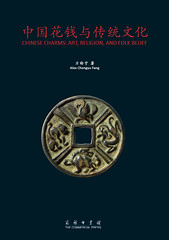 I have details now on Alex Fang's book.
Contents, captions, and some forwards by Western experts are in English,
but the background on charms as artistic and cultural objects is in
Chinese. The book still has not been distributed from the printer.
I have details now on Alex Fang's book.
Contents, captions, and some forwards by Western experts are in English,
but the background on charms as artistic and cultural objects is in
Chinese. The book still has not been distributed from the printer.The Song Dynasty (960 - 1279) bronze coin depicts a man on horseback attended by servants on the obverse. On the reverse, three people stand on a river bank, looking down at a person in the water.
"Some believe the front side depicts Xuan Wu (a Taoist god)," said Fang from the Department of Chinese, Translation and Linguistics, City University of Hong Kong (CityU). "Maybe... The God of North became an important icon in the Song Dynasty after Emperor Huizong had a dream about him."
But the story on the reverse is inexplicable. Who are the people on the bank? Why is there a person in the water? What does the charm signify? So far, Fang hasn't been able to find satisfactory answers.
When the coin was cast, the allusions should be unmistakable - "something people could tell with one look," Fang said. "But now nobody knows. A piece of our cultural heritage is lost, probably forever."
To read the complete article, see: Coins & culture (http://www.chinadaily.com.cn/hkedition/2008-07/30/content_6887499.htm)
For more information, see: http://www.coinhome.cn/viewthread.php?tid=12685&extra=page%3D1 (http://www.coinhome.cn/viewthread.php?tid=12685&extra=page%3D1)
COIN FICTION BOOK: THE VENETIAN BETRAYAL BY STEVE BERRY
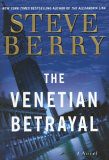 In Steve Berrys third Cotton Malone novel, The
Venetian Betrayal, several elements weave together to tell a story of
fear, domination, and the search for historical greatness. Someone has
been stealing elephant medallions that portray Alexander the Great. It is
suspected that Irina Zovastina, Supreme Minister of the Central Asian
Federation, is behind the thefts. Why? Some believe that Zovastina has
found the long-lost tomb of Alexander the Great. Meanwhile, an American
virologist has discovered a secret that will revolutionize HIV care. But
what is his connection with Zovastina? And why has retired US Justice
Department agent Cotton Malone, a bookseller in Copenhagen, been dragged
into the mess?
In Steve Berrys third Cotton Malone novel, The
Venetian Betrayal, several elements weave together to tell a story of
fear, domination, and the search for historical greatness. Someone has
been stealing elephant medallions that portray Alexander the Great. It is
suspected that Irina Zovastina, Supreme Minister of the Central Asian
Federation, is behind the thefts. Why? Some believe that Zovastina has
found the long-lost tomb of Alexander the Great. Meanwhile, an American
virologist has discovered a secret that will revolutionize HIV care. But
what is his connection with Zovastina? And why has retired US Justice
Department agent Cotton Malone, a bookseller in Copenhagen, been dragged
into the mess?NBS NUMISMATIC LITERATURE SYMPOSIUM AUGUST 1, 2008
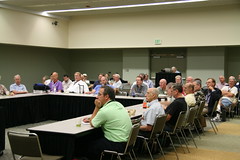
To view all the photos, see: NBS Events at 2008 ANA Convention (http://www.flickr.com/photos/coinbooks/sets/72157606525232199/)
NUMISMATIC LITERARY GUILD 2008 AWARD WINNERS
Numismatic Literary Guild webmaster Leon Worden writes:The work having the greatest potential impact on numismatics: Renaissance of American Coinage, 1909-1915, by Roger W. Burdette
BEST ARTICLE, LARGE PUBLICATIONS
"The ANS Celebrates 150 Years," Joe Ciccone, Robert Hoge and Peter Van Alfen, The ANS Magazine
BEST COLUMN
"Shades of the Blue and Grey," Fred L. Reed III, Bank Note Reporter
BEST ALL-AROUND PORTFOLIO (TIE)
- Q. David Bowers
- Dr. K.A. Rodgers
- Jeff Starck
JAMES L. MILLER MEMORIAL AWARD
Leon Worden, COINage, "Mr. Brenner's Lincoln"
E-SYLUM EDITOR WINS BURNETT MEMORIAL AWARD
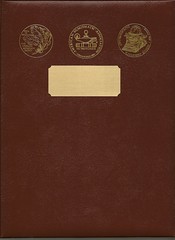 I got a pleasant surprise a couple weeks ago
while out at dinner with my family. It was Susan McMillan of the American
Numismatic Association calling to let me know I'd won the 2008 Burnett
Anderson award.
I got a pleasant surprise a couple weeks ago
while out at dinner with my family. It was Susan McMillan of the American
Numismatic Association calling to let me know I'd won the 2008 Burnett
Anderson award.The Burnett Anderson Memorial Award for Excellence in Numismatic Writing is presented annually to a researcher, author or journalist in recognition of his or her career contributions to numismatics and is judged on the recipients body of work. Past winners include Q. David Bowers, Beth Deisher, David Harper, R.W. Julian, Clifford Mishler, Eric P. Newman, Edward C. Rochette and Margo Russell.
The award is sponsored by F+W Publications (parent of Krause Publications) and presented under the auspices of the ANA, American Numismatic Society and the Numismatic Literary Guild. It was presented at the ANA Awards Banquet in Baltimore Saturday night by Burnett's son Mark.
It's very humbling to be in such august company. I was a bit taken aback when I saw the list of previous recipients. The award wasn't announced in advance so it came as a surprise to most of those at the banquet. I was a bit surprised myself when Mark Anderson handed me the mike to say something to the crowd of 500-some banquet attendees. I noted that I'd once met Burnette Anderson, the Washington correspondent for Numismatic News and mumbled something about the power of the technology that allows one guy with no budget, a laptop and an Internet connection to produce something worthwhile.
Many thanks to the ANA as well as those involved at the ANS and NLG. It's a triple treat to be honored by all three organizations. I only hope my work can continue to live up to the high standards of the award.
FRANK CAMPBELL AND THE ANS LIBRARY: AN APPRECIATION
What is the best way to get the most out of the ANS library? The best way is to go there and read absolutely everything. This strategy may not be possible, but even if one cannot do that, at least try to read more, and read more widely. A researcher who is interested in United States coins should not restrict research to the United States area of the bookshelves.
A researcher interested in United States coins would better spend the time reading through the Periodicals area the American Journal of Numismatics, the Numismatist, Frossards Numisma, the two series of the Coin Collectors Journal. (There is an excellent overview of United States numismatic periodicals by the late Ken Lowe published in Out on a Limb.)
But there is always something new to learn. I recently did some research in Mehls Numismatic Monthly. I had assumed that it would be worthless, as the Star Rare Coin Encyclopedia is said to be. To my surprise it is better than the Numismatist, partly because the Numismatist reflects the party line of Farran Zerbe, and thus is censored when discussing the disputes surrounding the 1909 ANA election, whereas Mehls Numismatic Monthly reports both sides.
Because of the lack of space in the old ANS library, periodicals were stored in a regular series then in a separate series for unbound periodicals and then in an exception to the exception. The Numismatist was in fat bound red volumes on the compact shelving upstairs; the Colonial News-Letter was unbound, in boxes in the periodicals room down a flight of stairs and through a door; and Coins magazine was stored in a third, locked, room, opposite the periodicals room and housing all sorts of remarkable objects, including a birdcage (but no birds). The birdcage may have been a remnant of when Frank raised homing pigeons; according to Witschonke, when North was running the library, Frank was able to keep his homing pigeons in the library. Thats one way to deliver interlibrary loans!
This system, with its many exceptions and exceptions to the exceptions could only be fully navigated with the help of a skilled pilot and this skill is what Frank provided. When the ANS moved to the building at Fulton and William Streets, the added space for the library enabled Frank and his assistant, Normand Ppin, to re-arrange the numismatic periodicals in one continuous series. This was tremendously helpful a number of periodicals that had been misshelved turned up again. I was overjoyed the day I came across a complete set of the Philippine Numismatic Monographs, with the fine hoard reports about Spanish American coins found in the Philippines, written by Dr. P. I. de Jesus.
Frank also had a locked room on the second floor of the old building that contained his ammunition duplicate volumes that he judiciously sold from time to time into the book trade, thereby increasing the librarys funds. For many years this locked room had a large supply of Clapp-Newcomb on the cents of 1795, 1796, 1797 and 1800 (which had been published by the ANS in 1947).
Even if you have read a book a million times, it is always useful to look at the ANS library copy. Why? Because people write in books. In a book published by Jos Torribio Medina about coins of the Americas I found a comment next to the description of the 10 reales of Santo Domingo Have seen in copper RIN. RIN are the initials of Robert I. Nesmith.
In the copy of Abe Kosoff Remembers, Kosoff commented that when he was trying to figure out whether the $20 gold piece with the Paquet reverse was a pattern or not, Wayte Raymond told him of a researcher that Raymond hired to look up things in the National Archives, and although Raymond did not tell Kosoff the name of the researcher, Kosoff could probably guess who it was. Next to this remark by Kosoff is a comment in purple ink, Yes, thanks Abe, WB. WB are the initials of Walter Breen. Thomas Hall wrote useful comments in his copy of Crosby on the cents of 1793.
At the farewell lunch for Frank Campbell, John W. Adams said that we might miss Frank now that he was leaving, but we would really miss him in five years, or even ten years time, when we remembered what we had lost and how much he had done for the library. The same sentiments were expressed to me in almost the same words a few weeks later by an advanced scholar of Roman imperial coins. Such was Franks influence, on the most diverse areas of numismatics.
John Kleeberg adds:
Frank named as users who knew the holdings very well myself and Eric P. Newman. Gary Trudgen then asked me to write an appreciation of Frank for the CNL, and since Rick Witschonke's ANS Magazine article pre-empted a biographical approach, I decided to get down on paper an overview of the collection, to encourage people to make more use of it.
There are a lot of manuscripts in the ANS library that should be transcribed and published. Examples are the bid books from the Chapman estate; Breen's card index to the auction catalogs; the purchasers at the New Netherlands sales; Homer K. Downing's notes of his conversations with Henry C. Hines; and the George Cogan correspondence scrapbook. I also love Henry Chapman's book of "Men Reported Bad" (collectors who bounced checks or paid slowly).
AN ODE TO THE DISAPPEARING LOCAL COIN CLUB LIBRARY
Are books becoming obsolete, as my wife ardently believes, in the age of the Internet?
Will books soon become only an antique collectible?
I was recently trying to research some history related to a numismatic item. A good friend, and much better researcher than me, found out about a book on microfiche at the Metropolitan Toronto Reference Library. Trying to read it was an eye-opener. There is a microfiche reader with a printer on the fourth floor of the library, but even with librarian assistance, it was virtually impossible to get an almost legible copy. There are no facilities to digitize or scan the microfiche. Instead you must spend 15 cents per sheet to produce a barely legible copy and attempt to transcribe it into a document you can use.
Many of the pages have gaps or unreadable stretches. Once you have the document digitized, does the library have the ability to store it digitally? A good question, but they seem too intimidated by copyright bullies to consider such a solution.
The main conclusion I reached in my work is the tremendous value and utility of the CNA library; definitely a hidden but valuable perk of membership. I cannot commend CNA librarian Dan Gosling highly enough; he is invaluable to serious numismatic researchers, and very helpful even to dilettantes like this writer.
As wedded as I am to electronic media, I certainly don't believe numismatic books are obsolete, nor do I think club libraries are a complete anachronism. But it is only through the efforts of dedicated individuals like Dan Gosling that they can survive and thrive, with or without electronic media.
THE BOOK BAZARRE
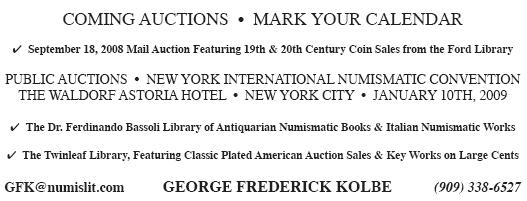
NUMISMATIC RESEARCHER BURDETTE APPOINTED TO COINAGE ADVISORY COMMITTEE
The United States Mint also announced today that the application process for appointment to an open position on the CCAC for a member representing the interests of the public has been extended to August 22, 2008. The United States Mint will review all applications and will forward recommendations to the Secretary of the Treasury for consideration.
The CCAC, established in 2003 by Public Law 108-15, advises the Secretary of the Treasury on themes and design proposals for circulating coinage, commemorative coins, bullion coinage, Congressional Gold Medals and other medals produced by the United States Mint. The CCAC also makes recommendations to the Secretary on the events, persons, or places commemorated on, as well as the mintage levels for, commemorative coins.
The 11-member committee includes: one specially qualified in numismatic collection curation; one specially qualified in the medallic arts or sculpture; one specially qualified in American history; one specially qualified in numismatics; three individuals representing the interests of the general public; and four individuals recommended by the Leadership of both the House of Representatives and Senate. CCAC members serve terms of four years and are Special Government Employees; therefore, they are subject to various applicable conflict of interest laws and ethics regulations.
Individuals who wish to be considered for appointment as a CCAC member representing the interests of the public should submit a letter, along with a rsum or curriculum vitae, detailing specific educational credentials, skills, talents and experience. Applications should be faxed to 202-756-6525, or mailed to the United States Mint, 801 9th St., N.W., Washington, DC 20220, Attn: Greg Weinman. Submissions must be postmarked no later than August 22, 2008.
For further information, please contact Clifford R. Northup, the United States Mint Liaison to the CCAC, at (202) 354-7463.
MORE ON COIN-MAKING AND BUTTON-MAKING
Dick Johnson writes:Thus we honor Mathew Boulton for his genius in bringing together all the factors that made his Soho Mint and his minting technology so successful. On the bicentennial of Boulton's death next year scholars, historians and numismatists from around the world will hold a Conference in his honor planned for July 2009 in Birmingham England. It is sponsored by the University of Birmingham and the University Central England. An extensive exhibit of all the coins, tokens and medals struck by Boulton will be on exhibit at the Birmingham Museums and Art Gallery. (See E-Sylum, Volume 11, Number 3, January 20, 2008, Article 9: MATTHEW BOULTON CONFERENCE PLANNED FOR JULY 2009 )
On the numismatic aspect of button manufacturers: I could site dozens more examples here in America (in addition to the obvious one of Scovill mentioned previously in E-Sylum). For example the J.R. Gaunt & Son firm (founded 1725), a London firm, established a branch in New York (Rouse's Point) about 1910. It replicated Washington's Button (Baker 1003S), and struck a Dahlia Society of New Jersey Medal (I once sold one of these), in addition to numerous sports award medals. Gaunt was striking these medals along side buttons. The New York branch was sold to the Waterbury Companies prior to World War II.
Again, another example of the close relationship of buttons and numismatic items. Similar technology, Carl. Thanks for your comments.
MORE ON THE NEW E-SYLUM FORMAT
First I typed in my name (Roger deWardt Lane) and it responded with 4,660,502 pages. The first hit was about a book that had my name on it as co-editor, although I had nothing to do with it but adding my numismatic credentials. Later editions happily did take my name off. So, I looked at their page 15 to jump ahead. There I found a reference to V8#27 July 3, 2005 of the E-Sylum. I clicked on the link and paged way down nearly half way through and there was a story I had written to you about the FUN convention many years ago and numismatics being mixed up as a church denomination. The part I liked best was where you tell about your trip to Wilmington, etc.
But, as I was re-reading a little bit of history, I kept reading the blog. It was like old-times. Almost no headings, no pictures, and best of all your folksy remarks as Editor.
Dont get me wrong; the current format is great, like a slick numismatic magazine (ANS or Numismatist). The pictures are fine and as the old saying goes a picture is worth a thousand words.
But I miss the old style where you pretty much had to read every line and spend an hour doing this (remember Im a numismatist and retired). Now I scan the blog in ten minutes look at all the pictures and partly read the headlines. I stop to read, except the book reviews and any item that sounds like numismatic news. I skip most of the summaries and links from newspapers or coin sites.
I miss the odd comments sent in to you by your readers. I wish you would get back to the style of the old days, where your personality always came through. The E-sylum will always be my Monday read, so take this as just a point of view from an old timer.
Comments from readers who came up to me at the Baltimore ANA were universally positive on the new format. Those who admitted to not reading each and every article (and I don't blame them!) were glad to have the added navigation, making it easy to scan the issue before going back to dive into specific articles in detail.
As for my folksy comments, they're still there, but I'll admit to having less time than before to write them. Demands of the day job and family keep me hopping, and time spent inserting images means a little less time available for writing editorials.
My numismatic diaries continue, although in most weeks my numismatic life is as dull as the suburban neighborhood I dwell in. It's our readers who have the most interesting things going on. So please do write in once in a while, either to react to an E-Sylum article, ask a question, or tell us a bit about your latest research. -Editor
WAYNE'S NUMISMATIC DIARY: JUNE 31 - AUGUST 1, 2008
 With great anticipation I left my office shortly
after 2pm Wednesday and pointed my car toward Dulles Airport. I parked my
car and raced toward the terminal. I was running a bit late, but luckily
so was Douglas Saville, whose flight from London's Heathrow airport was
about half an hour late. Douglas, the former head of the Spink book
department, was coming to the U.S. for the Baltimore ANA convention, and
we'd made plans to get together.
With great anticipation I left my office shortly
after 2pm Wednesday and pointed my car toward Dulles Airport. I parked my
car and raced toward the terminal. I was running a bit late, but luckily
so was Douglas Saville, whose flight from London's Heathrow airport was
about half an hour late. Douglas, the former head of the Spink book
department, was coming to the U.S. for the Baltimore ANA convention, and
we'd made plans to get together.I found the international arrivals gate and picked a spot to stand. The cleared area surrounded by short gates was where arriving passengers exit customs and parade past the crowd of friends, relatives and limo drivers. It reminded me a bit of the runway at a fashion show, except that only one party in the crowd of 300 or so cares that you exist. To the other 299 you're a disappointment. Passengers began slowly trickling out and were greeted by someone in the crowd.
My cell phone buzzed and it was Douglas - he would be out shortly. When he came out we were both relieved that our plans had paid off. We walked to my car and drove off, with me in the driver's seat on the left hand side of the vehicle, just the opposite of when Douglas chauffeured me around Reading and Oxford last summer. I was quite happy to repay the favor (or should I say "favour"?)
We drove past many new freeway ramps, office buildings and businesses. Northern Virginia is a bustling area - I found myself pointing out landmarks that didn't exist just two years ago when I moved here with my family.
We soon pulled up in front of my house. On entry I introduced Douglas to my eldest son Christopher, who was dressed in a swim suit for an outing to the neighborhood pool. We looked to the top of the stairs, and there was four-year-old Hannah standing in her birthday suit with her swimsuit in her hand. Next came my son Tyler and wife Dee. They were all ready to head to the pool, but we all stopped to chat for a bit.
Douglas had graciously brought gifts from the Heathrow shops - T-shirts for the kids and chocolate for Dee. The boys had several questions for Douglas. Tyler asked about the London Eye and the living statue street performers from Covent Garden - those are what he remembered most from my stories of living in London last summer.
When Dee took the kids to the pool, I drove Douglas around our neighborhood and stopped at Clyde's, a nice nearby restaurant. We had a couple of beers while we inspected the framed Audubon prints that lined the room. They were NOT originals, but still made an impressive sight. We stayed and ordered dinner. Before leaving we scouted a private room for and upcoming meeting of my numismatic social group, Nummis Nova.
By the time we left the restaurant traffic had died down and I pointed my car toward Baltimore. We arrived about 8pm and checked in to the Holiday Inn, where I immediately ran into NBS Board member Dan Friedus. After dropping our luggage in Douglas' room, we parked my car and walked thru the Inner Harbor area. On our way to Phillips' Seafood Restaurant we ran into dealer Steve Fenton of London, the onetime owner of the 1933 Saint-Gaudens Double Eagle.
Douglas and I took seats at Phillips' bar and ordered beers. ANA Governor Wendell Wolka & his wife were on their way out. I said hello and introduced them to Douglas. We had an enjoyable time. Douglas told me of some interesting coin book deals he'd made over the years.
As we walked back to the hotel, at about 10pm we ran info gaggle of bibliophiles coming the other direction as we crossed the street. The group consisted of NBS President John W. Adams, NBS cofounder George Kolbe, Joel Orosz, Len Augsburger and his wife. We had a cocktail-less cocktail party in the middle of the intersection until a car had the nerve to interrupt our chatter.
On Thursday morning Douglas and I walked over to the convention center and found the room for the Numismatic Ambassador breakfast. The annual event is a gathering of all past winners of the Numismatic News award. I became an Ambassador in 2002 and the beautiful plaque is hung proudly on the wall in my library.
I made certain to plan for the breakfast because it's the typically the greatest single gathering of top numismatists in the country. It would be a way for me to be sure to see as many friends as possible, and also introduce Douglas to many American collectors.
My plan paid off in spades. We found seats at a table occupied by dealer Claud Murphy and his wife Judith, Howard Daniel III and this year's Farran Zerbe award winner, Gene Hessler. I introduced Douglas, and soon we were joined by Celator publisher Kerry Wetterstrom, Sam Deep and David Lange. It was great to see everyone.
Publisher Fred Schwan of BNR Press swung by our table. At the far end of the room I spotted the Lancaster, PA contingent so John Eshbach, Dick Duncan and Jerry Kochel, whose collection was being auctioned by Heritage at the show.
At the next table was ANA Governor Wendell Wolka and shipwreck coin expert Tom Sebring. Riding in on an electric scooter was writer Ed Reiter. Also on a scooter/chair was longtime ANA officer Adna Wilde. He looked well and we spoke after the meeting. Although I didn't get to speak with them this time I also saw former ANA Executive Director Ed Rochette, Krause Publications' founder Chet Krause and Vince Alones.
I had nice chats with "Redbook" editor Ken Bressett and American Numismatic Society Executive Director Ute Wartenberg-Kagan. She was relieved that the move to the ANS' new location was complete. The new space sounds wonderful. We talked about the recent book sale, which raised about $100,000. We also discussed the library move, which was much easier this time. Rather than packing everything in boxes (which took months the last time), moving crews transferred the books onto shelving on wheels and rolled them on onto trucks and right into the new building. A new librarian has been hired, and a press release is forthcoming.
I also spoke with John and Nancy Wilson, former ANA librarian Nancy Green, George Cuhaj, Bob van Ryzin and many others (forgive me for not publishing every name)! People were very kind in their compliments on The E-Sylum. In the hallway afterwards I spoke with ANA Governor Joe Boling and numismatic literature dealer David Sklow. Barely 9am and already I'd talked with a Who's Who of American numismatics. Many thanks to Krause Publications and our host and emcee David Harper for a memorable event.
My next mission was to exchange my vouchers for Saturday's banquet for actual tickets. The booth wouldn't open until 10am so I bought a soft drink and looked for a seat. From across the lobby I'd spotted Colonial Coin Collectors club (C4) President Ray Williams and took the empty seat next to him. We had a nice conversation, partly about the recent books published by C4. Next I spoke to Pittsburghers Richard and Eva Crosby and Dick Gaetano.
Getting in line for the ticket exchange I ended up behind Roger Burdette and Gene Hessler, so I introduced them. David Sklow came by and invited me to join his table. Although I'd hoped to sit with my old Pittsburgh friends Sam Deep or my Lancaster PAN friends, their tables were already full, so Dave's offer was welcome. I got the tickets and headed into the bourse area.
Right near the entrance was the Kagin-Holabird table with a big glass display case of items from the firm's recent price list. I spoke for a while with Fred Holabird about our mutual friend Bob Evans (numismatic conservator of S.S. Central America fame) and the controversial U.S. Assay Office of Gold pieces (more on these in the next article).
John Wilson came by with ANA Executive Director Larry Shepherd in tow, and introduced me. I was glad to meet him and complimented him on his efforts to right the ship. He joked that this was his first new job where he didn't lie awake the first night worrying that he might screw things up. With things as bad as they were, the only way to go was up. John warned him that I'm a journalist (although I'd never been accused of that before...) But Larry was fine with letting me publish his remark, in the spirit of the new openness of the organization.
Next I briefly spoke with Traci Poole and Wayne Herndon, who was operating two large booths - his usual coin booth and a huge walk-in store setup for his Wizard Coin Supply business. It was a great arrangement with a wide array of coin supplies and numismatic books for sale. His staff sported colorful Wizard hats and could be spotted easily from across the bourse floor.
Next I stopped at Scott Loos' table and picked up a copy of George Selgin's Good Money. Scott said the shipment had been misplaced by his hotel and that he'd had to turn away half a dozen buyers who'd stopped by his table to buy the book.
From there I wandered down to the table of numismatic literature dealer John Burns where Sam Deep's grandson Josh Wadsworth was hanging out. Nearby was Mastronet's table, where I met Rich Mantia for the first time. We had a great talk. Rich showed me a number of interesting items from their upcoming sales, and gave me some elongated coins he'd had made to promote the use of Braille on coins to aid the blind. Rich is famous as the owner of the only Guide Book of United States Coins in Braille.
Soon it was time to go to the NBS Numismatic Literature Symposium. I'm out of time tonight but hope to hear from other attendees and write something up for next week's issue. After the Symposium I stayed in the room for a meeting of the NBS Officers.
Afterwards, Joel Orosz, Len Augsburger and I went to the bourse floor to meet Dennis Tucker of Whitman Publishing. We'd never met in person before. While waiting for Dennis to be available several folks stopped to chat, including Saul Teichman, whom I'd never met in person before.
Joel, Len, Dennis and I went down the street for lunch at The Wharf Rat brew pub, where we met Katie Jaeger and her friend Kay Freeman. The pair stayed and the group of us had a great conversation. It was my first time meeting Katie and Kay.
Back at the convention Joel and I chatted a bit and I signed a copy of my manuscript for An American Numismatist in London, a compilation of my E-Sylum London Diaries from last year. I gave it to Joel for Friday's NBS General Meeting, which I'd be unable to attend.
Time was running short. I dashed back into the bourse and quickly ran into Chick Ambrass and Ed Krivoniak, fellow members of the Western Pennsylvania Numismatic Society. I stopped by Charlie Davis' table, and had a short conversation with NBS VP Dan Hamelberg about soliciting ads for The E-Sylum and the NBS web site. From there I dashed to the exhibit area and met up with Joel again. We enjoyed reviewing the exhibits. Lots of nice ones!
Today was my day to meet a number of E-Sylum folks I knew previously only by email. While in the exhibit area medal collector John Sallay introduced himself and complimented me on The E-Sylum. Regular contributor Alan Weinberg made time to meet me (also for the first time in person), and he, Joel and I had a great conversation about the convention.
By 6:15 it was time for dinner. I met numismatic literature dealers George Kolbe, Douglas Saville and David Fanning in the lobby and the four of us went to Phillips' Seafood Restaurant for a nice leisurely dinner. At 9pm we bid adieu, and I walked to my car and drove home to Northern Virginia. I had to be at work Friday, and would miss the NBS General Meeting.
On Saturday, my wife Dee and I drove back to Baltimore for the ANA Banquet. More on this next week!
SUSPECT U.S. ASSAY OFFICE OF GOLD $20
This year's annual meeting at the ANA will consist of a special gathering of the Pioneer Gold Forum, to discuss the controversial proof and prooflike 1853 $20 U.S. Assay Office of Gold Pieces. These pieces were the subject of an inconclusive 1968 PNG (Professional Numismatists Guild - Editor) arbitration.
The Pioneer Gold Forum is an elite group of numismatic experts in the field of pioneer gold and have been carefully chosen for their abilities, willingness and impartiality toward analyzing controversial pioneer numismatic issues. Earlier this year, the Forum analyzed and concluded that the "Prooflike" 1861 Clark, Gruber & Co. $20s were 20th century fantasies, leading to PCGS' subsequent repurchase - and relabeling as fantasies - of erroneously certified overstruck specimens. This years' meeting takes place Saturday August 2, 2008 in Room #320 at the Baltimore Convention Center.

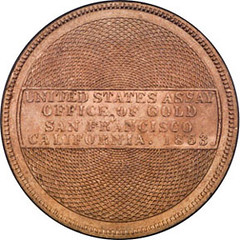
The above illustrations are from CoinFacts.com (not a contested piece). Prior to the meeting the topic was discussed in the Colonial Newsletter Foundation Google groups, where George Fuld revealed:
Of course all the so-called die trials of the USAO pieces came under the same "BAD" category
I started this coin study of the so-called proofs in early 1964 with a group Made up of Dr. James O. Sloss, Abe Kosoff, Eric Newman and myself. As a public service, the Metallurgy Research Laboratory of the Goodyear Tire and Rubber Co. did x-ray studies and photomicrographs and back scatter x-rays. All data was transmitted to Eric about six months later and he carried the ball up to the 1967-8 PNG hearing. One proof was sent to the Secret Service--but they declined to study it as they claimed that the USAO was not a government Mint until 1854 although the USAO was a U S government agency.
Except for some crocodile tears from the present owners of the "proof" twenties and associated trials, the 11:00 AM meeting at ANA on Saturday should put this whole subject to rest.
Of course the last big question is where the coins were made--they certainly weren't manufactured in Paul Franklin's garage!!
COINS EXHIBITED AT THE NATIONAL MUSEUM OF THE AMERICAN INDIAN
There are Spanish gold as well as silver coins from the New World...they were used in a novel ways. In one place on the time line a cross of silver coins is used to illustrate the introduction of coins to the New World as well as the church's influence... of course having my son along made the exhibits more interesting. He is very interested in Mezo-American Indian cultures, although his Masters at Oxford will be in Medical Anthropology. In another exhibit coins and currency with Indians were displayed....nicely done.
COUNTERFEIT CANADIAN $2 COINS DISCOVERED IN CIRCULATION
A suspected counterfeit $2 coin, the first reported in London, turned up in a vending machine at a plant in the city earlier this month.
Martin Hodgson, a vice-president at Williams Form Hardware on Industrial Road, became suspicious when a toonie jammed a pop machine inside the plant.
A collector, Hodgson said the toonie didn't get past the magnetic sensors in the vending machine because it wasn't magnetic like the real coin.
He said the toonie didn't look or sound real, and he suspects it's made of aluminum.
"It was too shiny and it sounded different when you dropped it on a desk -- sort of a clunking sound," he said.
The suspect toonie appeared slightly thicker than normal and the engraving was a bit sloppy when examined under a microscope, Hodgson said.
He called London police, who sent the toonie to an RCMP counterfeit lab in Ottawa for testing.
About 800 fake coins from across the country have been turned in to the RCMP lab in Ottawa during the past year, Laporte said.
Cpl. Elaine Laverne of the Quebec RCMP says a few other small counterfeit coin operations have been investigated in the province.
Laporte said the RCMP considers counterfeit coins a "rare" problem compared to fake bank notes, because of the machinery and expertise required and the much lower profit margins.
"They are so costly to produce it can outweigh the profit. It's not like making $100 bills" said Laporte.
To read the complete article, see:
(http://lfpress.ca/newsstand/News/Local/2008/07/29/6293521-sun.html)
BLIND TO TESTIFY BEFORE HOUSE SUBCOMMITTEE ABOUT PAPER MONEY CHANGES
Dr. Marc Maurer said: "I appreciate the opportunity to share the considered opinion of the National Federation of the Blind regarding paper currency. We represent the largest group of blind people in the United States, and each year we gather to consider important matters affecting the blind. We strongly disagree with the federal court ruling because the premise of the ruling is that the blind of America are being unlawfully made victims of discrimination because we lack "meaningful access" to paper money, which is patently untrue. Hundreds of thousands of blind people use paper money every day without difficulty. Identifying items by touch (including currency) is convenient, but not essential to the ability of blind people to participate fully in society. For a court to say that if we cannot identify it by touch, we can't use it is a fiction and a dangerous one. Millions of items that cannot be identified by touch must be managed by the blind in business, industry, and education every day; if the public comes to believe the myth that we cannot manage those items, then we will be denied the equality and opportunity we seek. If the paper money of the United States is to be changed, then the National Federation of the Blind must be consulted about what changes are to be made."
To read the complete article, see: National Federation of the Blind to Testify Before House Subcommittee (http://www.marketwatch.com/news/story/
national-federation-blind-testify-before/story.aspx?guid
=%7BB79C5208-930F-4062-BE73-816D2519949D%7D&dist=hppr)
FIRST-TIME METAL DETECTORISTS UNCOVER ROMAN COIN HOARD
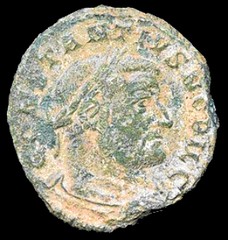 Three treasure hunters have unearthed 62 Roman
coins which date back 1,700 years.
Three treasure hunters have unearthed 62 Roman
coins which date back 1,700 years.Adam Staples, Lisa Grace and her 14-year-old son, Tom Grace - out with his metal detector for the first time made the discovery on land near Stanton-by-Bridge.
The trio, from Derby, were scouring the soil when their equipment began to beep.
Mr Staples scooped up the earth and in his hands were the first of 62 ancient coins they would find over the next six days.
To read the complete article, see: Treasure hunters' delight at the discovery of Roman coins bounty (http://www.thisisderbyshire.co.uk/news/Treasure-hunters
-delight-discovery-Roman-coins-bounty/article-242626-detail/
article.html)
ZIMBABWE'S INFLATION YET TO SURPASS HUNGARY'S
Alan Luedeking writes:

To read the complete article, see: Hey big spender: The world's highest-denomination banknotes (http://www.economist.com/daily/news/displaystory.cfm?story_id=11819514&fsrc=nwl)
U.S. AUTHORITIES INVESTIGATE BURIED LOOT
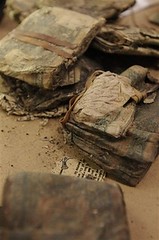 The businessman arrived at the Treasury
Department carrying a suitcase stuffed with about $5.2 million. The bills
were decomposing, nearly unrecognizable, and he asked to swap them for a
cashier's check. He said the money came from Mexico.
The businessman arrived at the Treasury
Department carrying a suitcase stuffed with about $5.2 million. The bills
were decomposing, nearly unrecognizable, and he asked to swap them for a
cashier's check. He said the money came from Mexico.Money like this normally arrives in an armored truck or insured shipping container after a bank burns or a vault floods. It doesn't just show up at the visitor's entrance on a Tuesday morning. But the banking habits of Franz Felhaber had stopped making sense to the government long ago.
For the past few years, authorities say, he and his family have popped in and out of U.S. banks, looking to change about $20 million in buried treasure for clean cash.
The money is always the same decaying $100 bills from the 1970s and 1980s.
Felhaber is a customs broker, a middleman.
His company, F.C. Felhaber & Co., is just minutes away from the bridge between El Paso, Texas, and Ciudad Juarez, Mexico. Tens of billions of dollars of Mexican goods cross that bridge each year, aided by people such as Felhaber who navigate the customs bureaucracy.
Customs brokers don't own the stuff that comes into the United States. They just make sure it gets here.
So it is with the $20 million. Felhaber says the money is not his.
To read the complete article, see: Buried loot a mystery for authorities (http://news.yahoo.com/s/ap/20080728/
ap_on_go_ca_st_pe/buried_millions)
OOPS! WRONG LARRY SHOWN ON IDAHO CAMPAIGN BUTTONS
But don't expect the staunch Republican to throw his support behind Obama or for the presidential candidate to ask Craig to change his mind and run for Senate again. Apparently the button manufacturer picked a picture of the wrong Idaho Larry.
The 3-inch button by Tigereye Design was intended to show Obama beside Larry LaRocco, the Democratic candidate for U.S. Senate, the Lewiston Tribune reported.
Craig is not seeking re-election following his arrest in a Minnesota airport restroom sex sting.
The buttons weren't ordered by the LaRocco campaign, said Dean Ferguson, LaRocco's communications director. They appear to have been produced by a commercial firm that makes campaign memorabilia involving Democratic races around the country, he said.
"That sounds like it's going to be a collector's item," Ferguson said. "I'm sure Sen. Obama appreciates Sen. Craig's support."
To read the complete article, see: Oops! Wrong Larry shown on Idaho campaign buttons (http://ap.google.com/article/ALeqM5i_6lCZ_WZvWDcDsJaTzJOoBt127wD926IGA80)
FEATURED WEB SITE: GALLERY OF BOOK TRADE LABELS
This week's featured web site is a Gallery of Book Trade Labels, recommended by Dan Freidus, who writes:From the web site:
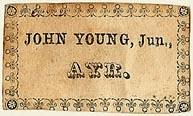
This collection began with labels found in our own books, but now it is mainly a virtual collection -- each entry is digitally scanned from books found in the excellent research library to which we repair in our spare time. We must admit to having gone from "coming across" the labels in our book-browsing to actually searching for them.
http://sevenroads.org/Bookish.html

